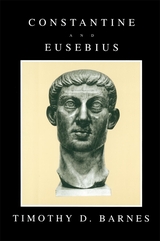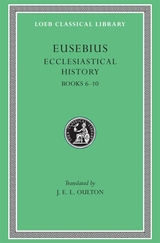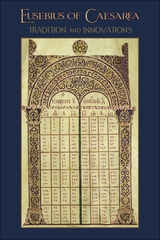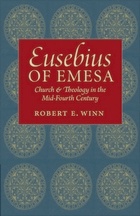
This study of the Roman Empire in the age of Constantine offers a thoroughly new assessment of the part Christianity played in the Roman world of the third and fourth centuries.
Timothy D. Barnes gives the fullest available narrative history of the reigns of Diocletian and Constantine. He analyzes Constantine’s rise to power and his government, demonstrating how Constantine’s sincere adherence to Christianity advanced his political aims. He explores the whole range of Eusebius’ writings, especially those composed before Constantine became emperor, and shows that many attitudes usually deemed typical of the “Constantinian revolution” were prevalent before the new Christian empire came into existence. This authoritative political and cultural history of the age of Constantine will prove essential to students and historians of the ancient world.

The first comprehensive history of early Christianity.
Eusebius of Caesarea (ca. AD 260–340), born in Palestine, was a student of the presbyter Pamphilus, whom he loyally supported during Diocletian’s persecution. He was himself imprisoned in Egypt, but became Bishop of Caesarea around 314. At the Council of Nicaea in 325 he sat by the emperor, led a party of moderates, and made the first draft of the famous creed.
Of Eusebius’ many learned publications we have the Martyrs of Palestine and the Life of Constantine; several apologetic and polemic works; parts of his commentaries on the Psalms and Isaiah; and the Chronographia, known chiefly in Armenian and Syriac versions of the original Greek. But Eusebius’ chief fame rests on the History of the Christian Church in ten books, published in 324–325, the most important ecclesiastical history of ancient times, a great treasury of knowledge about the early Church.

The first comprehensive history of early Christianity.
Eusebius of Caesarea (ca. AD 260–340), born in Palestine, was a student of the presbyter Pamphilus, whom he loyally supported during Diocletian’s persecution. He was himself imprisoned in Egypt, but became Bishop of Caesarea around 314. At the Council of Nicaea in 325 he sat by the emperor, led a party of moderates, and made the first draft of the famous creed.
Of Eusebius’ many learned publications we have the Martyrs of Palestine and the Life of Constantine; several apologetic and polemic works; parts of his commentaries on the Psalms and Isaiah; and the Chronographia, known chiefly in Armenian and Syriac versions of the original Greek. But Eusebius’ chief fame rests on the History of the Christian Church in ten books, published in 324–325, the most important ecclesiastical history of ancient times, a great treasury of knowledge about the early Church.



THIS EDITION HAS BEEN REPLACED BY A NEWER EDITION.
Novel and biography are joined in this literary work with a historical core. Philostratus' life of the first century mystic from Tyana was written at the request of the empress Julia Domna. It portrays a man with supernatural powers, a Pythagorean who predicts the future, cures the sick, raises the dead, and himself prevails over death, ascending to heaven and later appearing to disciples to prove his immortality. The account has a rich and varied setting: Apollonius' ministering carries him throughout the eastern Mediterranean world, as far south as Ethiopia, and eastward to India. Philostratus' Life of Apollonius was long viewed by Christians as a dangerous attempt to set up a Christ-like rival.
This two-volume edition of the Life of Apollonius of Tyana includes, in the second volume, a collection of Apollonius' letters and a treatise by the Christian bishop and historian Eusebius attacking Apollonius as a charlatan.
Also available by Philostratus 'the Athenian' in the Loeb Classical Library is his Lives of the Sophists, a treasury of information about notable sophists that yields a good picture of the predominant influence of Sophistic in the educational, social, and political life of the Empire in the 2nd and 3rd centuries.
READERS
Browse our collection.
PUBLISHERS
See BiblioVault's publisher services.
STUDENT SERVICES
Files for college accessibility offices.
UChicago Accessibility Resources
home | accessibility | search | about | contact us
BiblioVault ® 2001 - 2025
The University of Chicago Press









